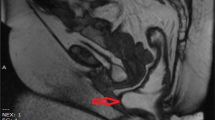Abstract
Bladder and bowel symptoms rarely occur in isolation and many are due to adaptive strategies; furthermore, multipathology often exists. To fully understand the pathophysiology of lower urinary tract (LUT) disorders, information is required about any problems during bladder filling and emptying, and the character, onset and duration of symptoms. Furthermore, all past and present obstetric, gynaecological, urological, medical and relevant surgical history should be documented, along with current drug therapy, including over-the-counter (OTC) medication. Finally, a physical examination is carried out, examining the abdomen, external genitalia and pelvic floor muscles.
Access this chapter
Tax calculation will be finalised at checkout
Purchases are for personal use only
Preview
Unable to display preview. Download preview PDF.
Similar content being viewed by others
References
Abrams P, Feneley R, Torrens M (1983) Patient assessment. In: Abrams P, Feneley R, Torrens M (ed) Urodynamics. Springer, Berlin, pp. 6–27.
Cardozo L (1988) Sex and the bladder. Br Med J 296: 587–8.
Hilton P (1988) Urinary incontinence during sexual intercourse: a common, but rarely volunteered symptom. Br J Obstet Gynaecol 95: 377–81.
Laycock J, Jerwood D (2001) Pelvic floor assessment; the PERFECT scheme. Physiotherapy. 87: 12: 631–642.
Bump RC, Hurt W, Fantl A, Wyman JF (1991) Assessment of Kegel pelvic muscle performance after brief verbal instruction. Am J Obstet Gynecol 165: 322–9.
RCOG (1997)Intimate Examinations. Report of a Working Party. Royal College of Obstetricians and Gynaecologists Press, London.
De Groat WC and committee (1999) Basic neurophysiology and neuropharmacology. In: Abrams P, Khoury A, Wein A (ed) Incontinence. Plymbridge Distributors, UK, pp. 107–19.
Shull B L and committee (1999) Physical examination. In: Abrams P, Khoury A, Wein A (ed) Incontinence. Plymbridge Distributors, UK, pp. 335–49.
Fantl A, Cardozo L McClish D and the Hormones and Urogenital Therapy Committee (1994) Estrogen therapy in the management of urinary incontinence in postmenopausal women: a meta-analysis. Obstet Gynecol 83: 12–18.
DeLancey JOL and committee (1999) Pregnancy, childbirth and the pelvic floor. In: Abrams P, Khoury A, Wein A (ed) Incontinence. Plymbridge Distributors, UK, pp. 287–94.
Kirschner-Hermanns R, Wein B, Niehaus S et al. (1993) The contribution of magnetic resonance imaging of the pelvic floor to the understanding of urinary incontinence. Br J Urol 72: 715.
Miller J, Ashton-Miller JA, DeLancey JOL (1996) The Knack: use of precisely-timed pelvic muscle contraction can reduce leakage in SUI. Neurourol Urodynamics 15 (4): 392–3.
Donovan J and committee (1999) Symptom and quality of life assessment. In: Abrams P, Khoury A, Wein A (ed) Incontinence. Plymbridge Distributors, UK, pp. 295–332.
Editor information
Editors and Affiliations
Rights and permissions
Copyright information
© 2002 Springer-Verlag London
About this chapter
Cite this chapter
Laycock, J. (2002). Patient Assessment. In: Laycock, J., Haslam, J. (eds) Therapeutic Management of Incontinence and Pelvic Pain. Springer, London. https://doi.org/10.1007/978-1-4471-3715-3_6
Download citation
DOI: https://doi.org/10.1007/978-1-4471-3715-3_6
Publisher Name: Springer, London
Print ISBN: 978-1-85233-224-2
Online ISBN: 978-1-4471-3715-3
eBook Packages: Springer Book Archive




